engine PONTIAC PONTIAC 1996 Owners Manual
[x] Cancel search | Manufacturer: PONTIAC, Model Year: 1996, Model line: PONTIAC, Model: PONTIAC PONTIAC 1996Pages: 370, PDF Size: 17.69 MB
Page 2 of 370
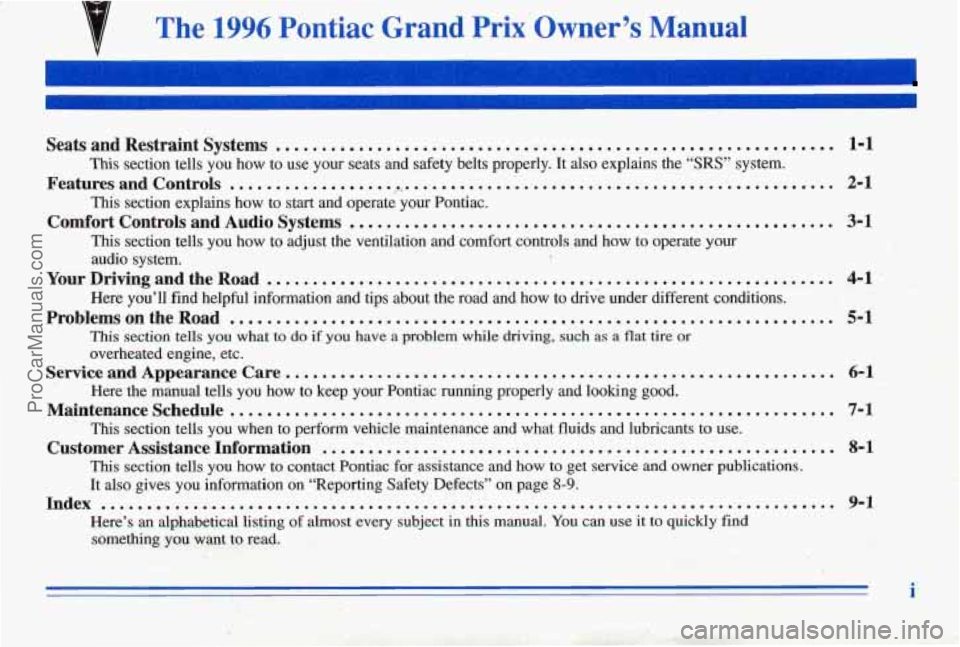
{ The 1996 Pontiac Grand Prix Owner’s Manual
SeatsandRestraintSystems ............................................................. 1-1
This section tells you how to use your seats and safety belts prop\
erly. It also explains the “SRS” system.
This section explains how to start and operate your Pontiac.
This section tells you how to adjust the ventilation and comfort co\
ntrols and how to operate your
audio system.
Here you’ll find helpful information and tips about the road\
and how to drive under different conditions.
This section tells you what to do if you have a problem while driving, such as a flat tire or
overheated engine, etc. Here the manual tells you how to keep your Pontiac running pr\
operly and looking good.
This section tells you when to perform vehicle maintenance and what \
fluids and lubricants to use.
This section tells you how to contact Pontiac for assistance and how to get service and owner pubiications.
It also gives you information on “Reporting Safety Defects”\
on page
8-9.
Here’s an alphabetical listing of almost every subject in this manual. You can use it to qbickly find
something you want to read.
Features and Controls ................................................................... 2-1
ComfortControlsandAudioSystems ..................................................... 3-1
YourDrivingandtheRoad .............................................................. 4-1
ProblemsontheRoad .................................................................. 5-1
Service and Appearance Care. ........................................................... 6-1
Maintenanceschedule .................................................................. 7-1
Customer Assistance Information ........................................................ 8-1
Index ........................................................................\
......... 9-1
i
ProCarManuals.com
Page 6 of 370
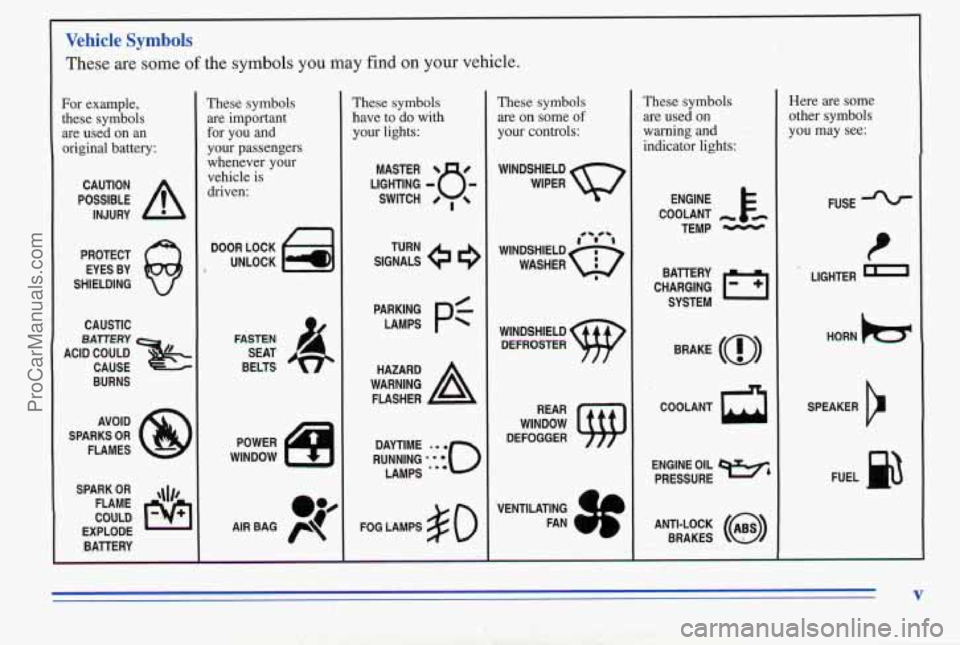
1
Vehicle Symbols
These are some of the symbols you may find on your vehicle.
For example,
these symbols are used on an
original battery:
POSSIBLE A
CAUTION
INJURY
PROTECT EYES BY
SHIELDING
CAUSTIC
ACIEEZ CAUSE
BURNS
AVOID
SPARKS
OR
FLAMES
SPARK
OR ,\I/,
COULD FLAME
EXPLODE BATTERY
These symbols
are important
for you and
your passengers
whenever your
vehicle is driven:
DOOR LOCK
UNLOCK
FASTEN SEAT
BELTS
POWER
WINDOW
c
These symbols
have to do with
your lights:
SIGNALS e 9
TURN
PARKING
PC
LAMPS
FOG LAMPS $0
These symbols
are
on some of
your controls:
WINDSHIELD
WIPER
'VENTILATING
FAN
These symbols
are used on
warning and
indicator lights:
COOLANT -
TEMP -
CHARGING 1-1
BATTERY
SYSTEM
BRAKE
(0)
COOLANT a
ENGINE OIL w,
PRESSURE
ANTI-LOCK
(@)
BRAKES
Here are some
other symbols
you may see:
FUSE
P
LIGHTER m
HORN )cr
SPEAKER
b
FUEL e3
V
ProCarManuals.com
Page 76 of 370
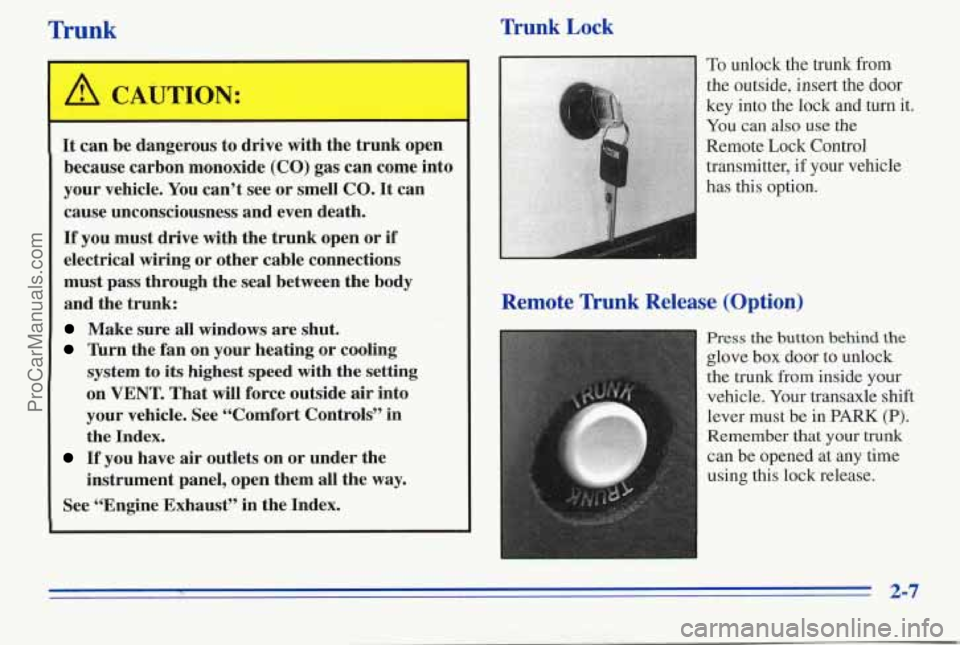
Trunk Trunk Lock
A CAUTION:
It can be dangerous to drive with the trunk open
because carbon monoxide (CO) gas can come into
your vehicle. You can’t see or smell CO.
It can
cause unconsciousness and even death.
If you must drive with the trunk open or if
electrical wiring or other cable connections
must pass through the seal between the body
and the trunk:
Make sure all windows are shut.
7hrn the fan on your heating or cooling
system to
its highest speed with the setting
on
VENT. That will force outside air into
your vehicle. See “Comfort Controls” in
the Index.
instrument panel, open them
all the way.
If you have air outlets on or under the
See “Engine Exhaust” in the Index.
To unlock the trunk from
the outside, insert the door
key into the lock and turn it.
You can also use the
Remote Lock Control
transmitter, if your vehicle
has this option.
Remote Trunk Release (Option)
Press the button behind the
glove box door to unlock
the trunk from inside your
vehicle.
Your transaxle shift
lever
must be in PARK (P).
Remember that your trunk
can be opened at any time
using this lock release.
2-7
ProCarManuals.com
Page 78 of 370

When the PASS-Key I1 system senses that someone is
using the wrong key, it shuts down the vehicle’s starter
and fuel systems. For about three minutes, the starter
won’t work and fuel won’t
go to the engine. If someone
tries to start your vehicle again or uses another key
during this time, the vehicle will not start. This
discourages someone from randomly trying different
keys with different resistor pellets in an attempt to make
a match.
The ignition key must be clean and dry before it’s
inserted in the ignition or the engine may not start.
If the
engine does not start and the SECURITY light is on,
the
key may be dirty or wet. Turn the ignition off.
Clean and dry the, key. Wait about three minutes and try
again. The SECURITY light may remain on during this
time.
If the starter still won’t work, and the key appears
to be clean and dry, wait about
three minutes and try
another ignition key. At this time, you may also want to
check the fuse (see “Fuses and Circuit Breakers” in the
Index).
If the starter won’t work with the other key, your
vehicle needs ‘service. If your vehicle does start, the first
ignition key may
be faulty. See your Pontiac dealer or a
locksmith who can service
the PASS-Key 11.
If you accidentally use a key that has a damaged or
missing resistor pellet, the starter won’t work and the
SECURITY light will flash. But you don’t have to wait
three minutes before trying another ignition key.
See your Pontiac dealer
or a locksmith who can service
the PASS-Key
11 to have a new key made.
If you’re ever driving and
the SECURITY light comes
on, you will be able to restart your engine
if you turn
it off. Your PASS-Key 11 system, however, is not
working properly and must
be serviced by your
Pontiac dealer. Your vehicle is not protected by the
PASS-Key
I1 system.
If you lose or damage a PASS-Key
II ignition key,
see your Pontiac dealer or a locksmith who can service
PASS-Key I1 to have a new key made. In an emergency,
call the Pontiac Roadside Assistance Program at
1-800-ROADSIB or 1-800-762-3743.
2-9
ProCarManuals.com
Page 79 of 370

New Vehicle 66Break-InS’ Ignition Positions
Your modern Pontiac doesn’t need an elaborate
“break-in.” But
it will perform better in the long
run
if you follow these guidelines:
Don’t drive at any one speed
-- fast or
slow
-- for the first 500 miles (804 km).
Don’t make full-throttle starts.
Avoid making hard stops for the first
200 miles (322 km) or so. During this time
your new brake linings aren’t
yet broken
in. Hard stops with new linings can mean
premature wear and earlier replacement.
Follow this breaking-in guideline every
time
you get new brake linings.
Don’t tow a trailer during break-in, See
‘‘Towing a Trailer’’ in the Index for more
information.
C
A i E
With the ignition key in the ignition switch, you can twn
the switch to five positions.
ACC (A): This position lets you use things like the
radio and windshield wipers when the engine is
off. To
use ACC (Accessory), push in the key and turn it toward
you. Your steering wheel will stay locked.
LOCK (B): Before you put the key into the ignition
switch, the switch
is in the LOCK position. It’s also the
only position in which you can remove your key.
This
position locks your ignition, steering wheel and
transaxle. It’s a theft-deterrent feature.
ProCarManuals.com
Page 80 of 370
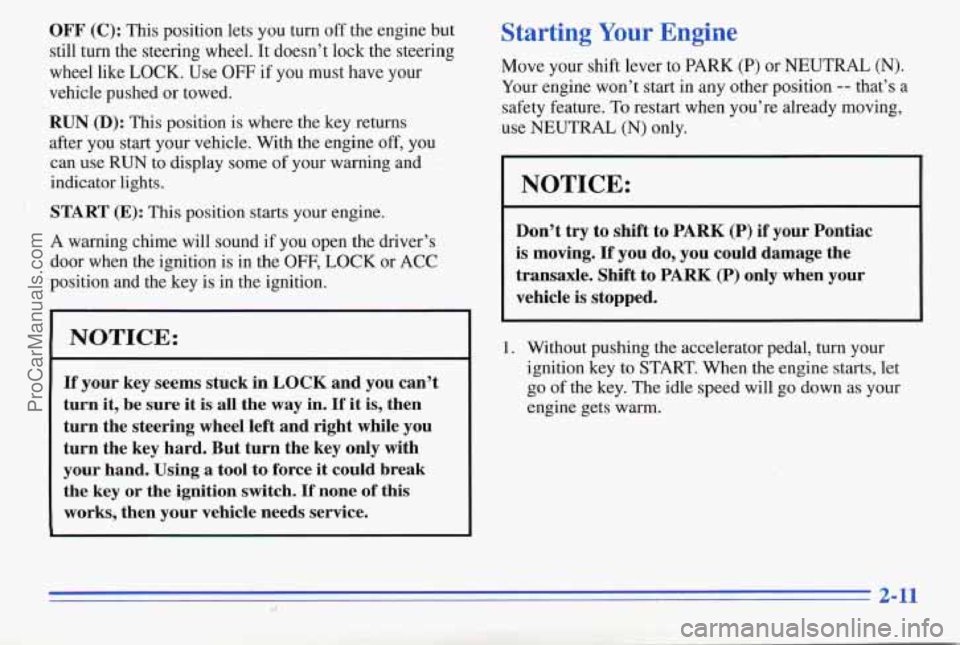
OFF (C): This position lets you turn off the engine but
still tuin the steering wheel. It doesn’t lock the steering
wheel like
LOCK. Use OFF if you must have your
vehcle pushed
or towed.
RUN (D): This position is where the key returns
after you start your vehicle. With the engine
off, you
can use
RUN to display some of your warning and
indicator lights.
: START (E): This position starts your engine.
A warning chime will sound
if you open the driver’s
door when the ignition is in the
OFF, LOCK or ACC
position and the key
is in the ignition.
NOTICE:
If your key seems stuck in LOCK and you can’t
turn it, be sure it
is all the way in. If it is, then
turn the steering wheel left and right while you
turn the key hard. But turn the key only with
your hand. Using
a tool to force it could break
the key or the ignition switch.
If none of this
works, then your vehicle needs service.
Starting Your Engine
Move your shift lever to PARK (P) or NEUTRAL (N).
Your engine won’t start in any other position -- that’s a
safety feature.
To restart when you’re already moving,
use
NEUTRAL (N) only.
NOTICE:
Don’t try to shift to PARK (P) if‘ your Pontiac
is moving.
If you do, you could damage the
transaxle. Shift to PARK
(P) only when your
vehicle is stopped.
1. Without pushing the accelerator pedal, turn your
ignition key
to START. When the engine starts, let
go of the key. The idle speed will go down as your
engine gets warm.
2-11
ProCarManuals.com
Page 81 of 370
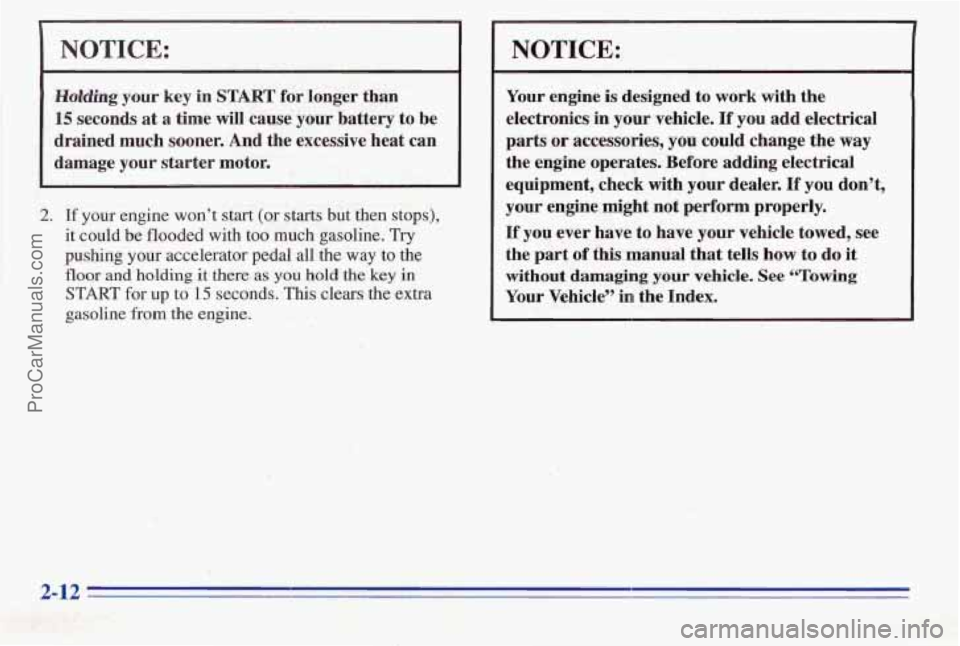
NOTICE:
Hdding your key in START for longer than
15 seconds at a time will cause your battery to be
drained much sooner. And the excessive heat can
damage your starter motor.
2. If your engine won’t start (or starts but then stops),
it could be flooded with too
much gasoline. Try
pushing your accelerator pedal all the way to the
floor and holding it there as you hold the key in
START for up to 15 seconds. This clears the extra
gasoline from the engine.
4
NOTICE:
Your engine is designed to work with the
electronics in your vehicle.
If you add electrical
parts
or accessories, you could change the way
the engine operates. Before adding electrical
equipment, check with
your dealer. If you don’t,
your engine might not perform properly.
If’ you ever have to have your vehicle towed, see
the part
of this manual that tells how to do it
without damaging your vehicle. See “Towing
Your Vehicle” in the Index.
2-12
ProCarManuals.com
Page 82 of 370

Engine Coolant Heater (Option)
In very cold weather, 0" F
(- 18 O C) or colder, the
engine coolant heater can
help. You'll get easier
starting and better fuel
economy during
engine warm-up.
A I
I A CAUTION: I
Plugging the cord into an ungrounded outlet
could cause an electrical shock. Also, the wrong
kind
of extension cord could overheat and cause
a fire. You could be seriously injured. Plug the
cord into a properly grounded three-prong 110-volt AC outlet.
If the cord won't reach, use a
heavy-duty three-prong extension cord rated for
I at least 15 amps.
4. After you've used the coolant heater, be sure to store
Usually, the coolant heater should be plugged in a the cord as it was before to keep it away from
minimum of four hours prior to starting your vehicle. moving engine parts. If you don't, it could
' - be damaged. To Use the- Coolant Heater
How long should you keep the coolant heater plugged
1. Turn off the engine.
in? The answer depends on the outside temperature, the
2. Open the hood and unwrap the electrical cord. kind of oil you have, and some other things. Instead of
.. - .. ' . ':. 1 :\'. . . .. .
~ ~
3. Plug it into a normal, grounded 110-volt AC outlet. trying to list
everything here, we ask that you contact
your Pontiac dealer in tlie area where you'll be parking
your vehicle. The dealer can give you-the best advice for
that particular area,
ProCarManuals.com
Page 83 of 370
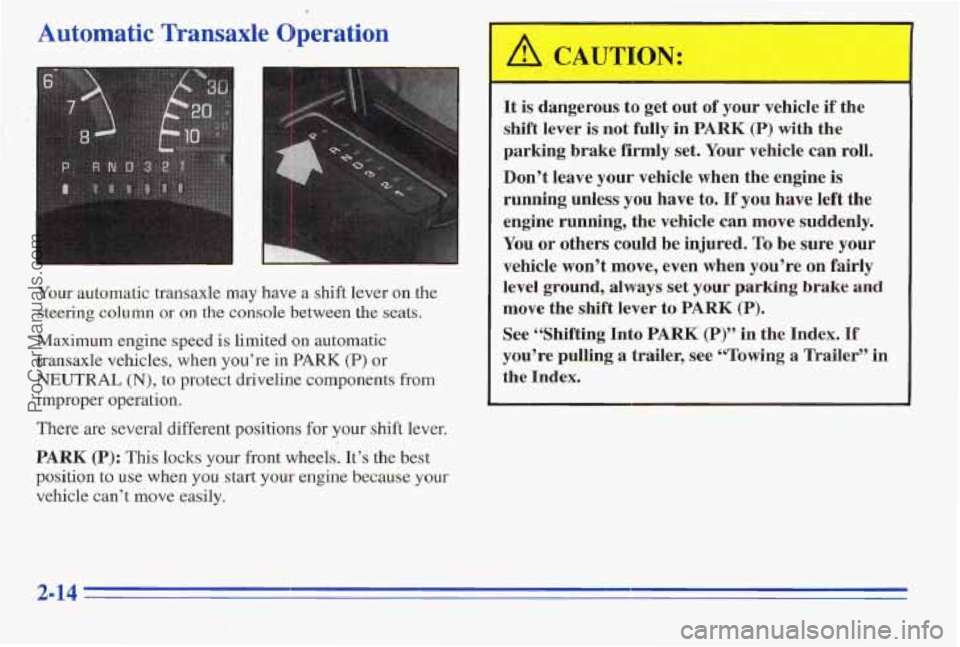
Automatic Transaxle Operation
Yom automatic transaxle may have a shift lever on the
steering
column or on the console between the seats.
Maximum engine speed is limited
on automatic
transaxle vehicles, when you’re in
PARK (P) or
NEUTRAL (N), to protect driveline components from
improper operation.
There are several different positions for your shift lever.
PARK (P): This locks your front wheels. It’s the best
position to use when you start your engine because your
vehicle can’t move easily.
/I CAUTION:
It is dangerous to get out of your vehicle if the
shift lever is not
fully in PARK (P) with the
parking brake firmly set. Your vehicle can roll.
Don’t leave
your vehicle when the engine is
running unless you have to. If you have left the
engine
running, the vehicle can move suddenly.
You or others could
be injured. To be sure your
vehicle won’t move, even when you’re on fairly
level ground,
always set your parking brake and
move the shift lever to PARK (P).
See “Shifting Into PARK (P)” in the Index. If
you’re pulling a trailer, see LCTo~ing a Trailer” in
the Index.
ProCarManuals.com
Page 84 of 370

Make sure the shift lever is fully into PARK (P) range
before starting the engine. Your Pontiac has a
brake-transaxle shift interlock. You must fully apply
your regular brakes. before you can shift from PARK (P)
when the ignition is in the RUN position. If you cannot
shift out of PARK (P), ease pressure on the shift lever by
pushing it all the way into PARK (P) while keeping the
brake pedal pushed down. Release the shift lever button
if you have a console shift. Then move
the shift lever
out of PARK
(P), being sure to press the shift lever
button if you have a console shift. See “Shifting Out
of
PARK (P)” in the Index.
REVERSE (R): Use this gear to back up.
NOTICE:
.. .. ‘9: -. ~. - , . .. I. .,, :- . *.
Shifting to REVERSE (R) while your vehicle is
moving
forward could damage your transaxle.
Shift to REVERSE
(R) only after your vehicle
is stopped.
To rock your vehicle back and forth to get out of snow,
ice or sand without damaging your transaxle, see
“Stuck: In Sand,
Mud, Ice or Snow” in the Index.
NEUTRAL (N): In this position, your engine
doesn’t connect with the wheels. To restart when you’re
already moving, use NEUTRAL (N) only. Also, use
NEUTRAL (N) when your vehicle is being towed.
Shifting out of PARK (P) or NEUTRAL (N) while
your engine is “racing” (running
at high speed) is
dangerous. Unless your foot is firmly on the
brake pedal, your vehicle could move very
rapidly. You could lose control and hit people or
objects. Don’t shift out
of PARK (P) or
NEUTRAL (N) while your engine is racing.
NOTICE:
Damage,to your transaxle caused by shifting out
of PARK (P) or NEUTRAL (N) with the engine
racing isn’t covered by your warranty.
2-15
ProCarManuals.com